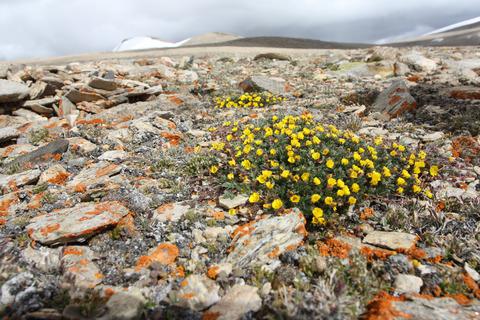当前位置:
X-MOL 学术
›
Funct. Ecol.
›
论文详情
Our official English website, www.x-mol.net, welcomes your
feedback! (Note: you will need to create a separate account there.)
Contrasting biomass allocation responses across ontogeny and stress gradients reveal plant adaptations to drought and cold
Functional Ecology ( IF 4.6 ) Pub Date : 2020-09-22 , DOI: 10.1111/1365-2435.13687 Jiri Dolezal 1, 2 , Veronika Jandova 1, 2 , Martin Macek 1 , Pierre Liancourt 1, 3
中文翻译:

个体发育和应力梯度上不同的生物量分配响应揭示了植物对干旱和寒冷的适应
更新日期:2020-09-22
Functional Ecology ( IF 4.6 ) Pub Date : 2020-09-22 , DOI: 10.1111/1365-2435.13687 Jiri Dolezal 1, 2 , Veronika Jandova 1, 2 , Martin Macek 1 , Pierre Liancourt 1, 3
Affiliation

|
- How plants allocate their biomass to different organs is essential to understanding plant adaptations and distributions. Overall, biomass allocation may follow fixed rules across taxa. They are also likely to exhibit substantial departure from these rules during ontogeny and in response to particular limiting factors to optimize their growth and maximize their survival. However, how plants adjust their allocation priorities depending on size and age across stress gradients remain largely unknown in wild populations.
- We examined ontogenetic variation in biomass allocation in Himalayan forb Potentilla pamirica across its 5,250–5,900‐m elevation range, between populations from dry steppe, wet alpine and cold subnival zone. We evaluated whether biomass allocation followed optimal partitioning or fixed allometric rules using organ mass in 1,019 individuals spanning 1–73 years.
- We found shifting biomass fractions with plant size and age, supporting the optimal partitioning theory. Young plants (<10 years) allocated similar proportions of biomass to leaves, stems and roots, intermediate‐aged plants (10–30 years) allocated more biomass to roots, while the oldest plants had 90% biomass in below‐ground stems.
- Major developmental processes including secondary thickening, branching and flowering begin 10–15 years earlier under more thermally favourable steppe conditions. Young steppe plants are larger than alpine and subnival plants, but these differences disappear in plants aged ~30, and the oldest alpine and subnival plants are larger than steppe plants.
- Plant age exerted significant control over biomass allocation after controlling for plant size. While in steppe plants the preference for stem biomass allocation increases with both size and age, for large alpine and subnival plants the stem prioritization decreases with age in favour of root and leaf mass fractions. We interpret root and leaf prioritization in older plants as a way to reduce carbon imbalances and the risk of frost damage to secure long life.
- Our analyses rejected ontogenetically fixed allometry and instead found high variation in biomass allocation depending on age, size and environment, supporting optimal partitioning theory. The uneven allocation of resources to different structures and functions during ontogenesis reflects plant adaptations to different levels of low‐temperature and water stress across species elevation range.
中文翻译:

个体发育和应力梯度上不同的生物量分配响应揭示了植物对干旱和寒冷的适应
- 植物如何将生物量分配给不同的器官对于理解植物的适应性和分布至关重要。总体而言,生物量的分配可能遵循整个分类单元的固定规则。它们还可能在个体发育过程中以及对特定限制因素的响应中表现出与这些规则的重大背离,以优化其生长并最大化其生存率。然而,在野生种群中,植物如何根据大小和年龄跨压力梯度来调整其分配优先级仍然未知。
- 我们研究了喜马拉雅山五角委陵菜在海拔5,250-5,900-m范围内,干草原,湿高山和冷亚热带地区的种群之间生物量分配的个体发育差异。我们评估了在1至73年间的1,019名个体中,使用器官的质量来确定生物量的分配是遵循最佳分配还是遵循固定的变长规则。
- 我们发现随植物大小和年龄而变化的生物量部分,支持最佳分配理论。幼小植物(<10年)向叶片,茎和根分配相似的生物量比例,中年植物(10-30年)向根分配更多的生物量,而最老的植物在地下茎中具有90%的生物量。
- 在较热有利的草原条件下,包括二次增厚,分支和开花的主要发育过程要早10-15年开始。幼小的草原植物比高山和亚热带植物大,但这些差异在30岁以上的植物中消失,最古老的高山和亚热带植物比草原植物大。
- 在控制植物大小后,植物年龄对生物量的分配具有重要的控制作用。在草原植物中,对茎生物量分配的偏好随着大小和年龄的增加而增加,而对于大型高山和亚热带植物,茎的优先级随年龄的增加而降低,有利于根和叶的质量分数。我们将老龄植物的根和叶优先级解释为减少碳不平衡和结霜风险以确保长寿命的一种方法。
- 我们的分析拒绝了本体论上固定的异速生长法,而是发现了生物量分配的高度变化,取决于年龄,大小和环境,支持了最佳的分配理论。在本体形成过程中,资源向不同结构和功能的分配不均,反映了植物对整个物种海拔范围内不同水平的低温和水分胁迫的适应能力。











































 京公网安备 11010802027423号
京公网安备 11010802027423号